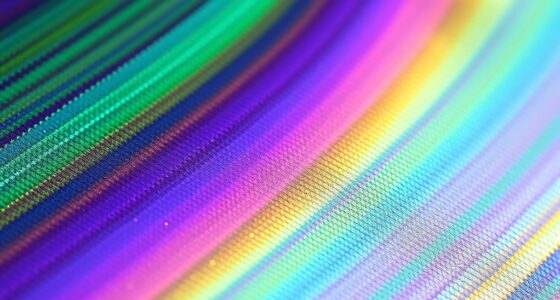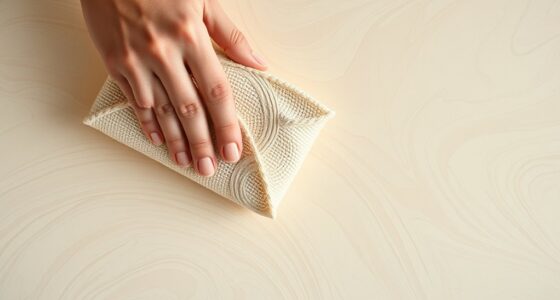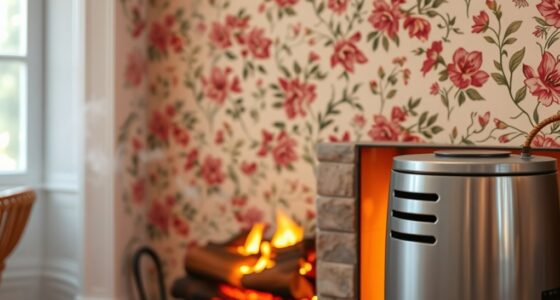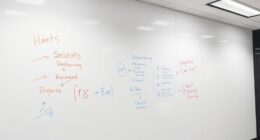When estimating wallpapering costs, you should consider the type of wallpaper you choose, as prices vary with quality, pattern complexity, and material. Don’t forget surface prep and repair, which impact time and expenses. Labor rates depend on your location and project complexity, especially with intricate patterns or large areas. Using the right tools and planning wisely can help manage costs. If you keep exploring, you’ll find ways to optimize your wallpaper project efficiently.
Key Takeaways
- Material costs depend on wallpaper type, quality, design complexity, and waste during installation.
- Surface preparation and necessary tools influence labor and overall expenses.
- Pattern matching and design intricacy increase installation time and material usage.
- Regional market rates and geographic location significantly affect labor and material costs.
- Planning for supply chain issues and seasonal variations helps control overall wallpapering expenses.
Types of Wallpaper and Their Costs
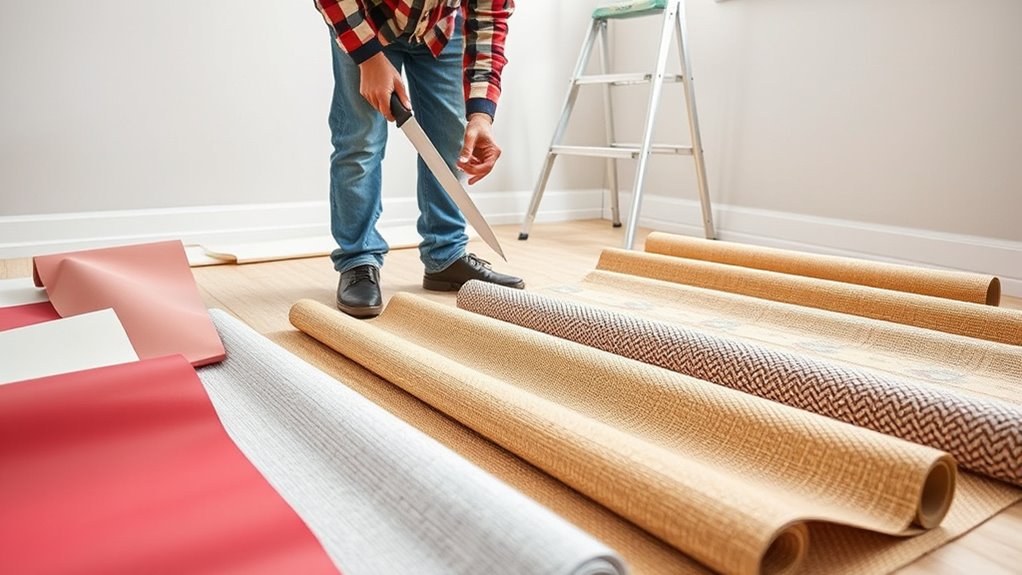
When choosing wallpaper, understanding the different types and their costs is essential. Vinyl wallpapers are popular due to their durability and ease of cleaning, making them a cost-effective choice for high-traffic areas. They come in various styles, including solid colors, patterns, and textured finishes that add depth and personality to your space. Textured finishes, in particular, can range from subtle patterns to bold, three-dimensional designs, often at a slightly higher price point. The cost of vinyl wallpapers varies based on quality, design complexity, and brand, so you’ll want to contemplate your budget and desired aesthetic. Investing in the right type of wallpaper can enhance your room’s look while fitting your financial plan.
Surface Preparation and Repair Expenses
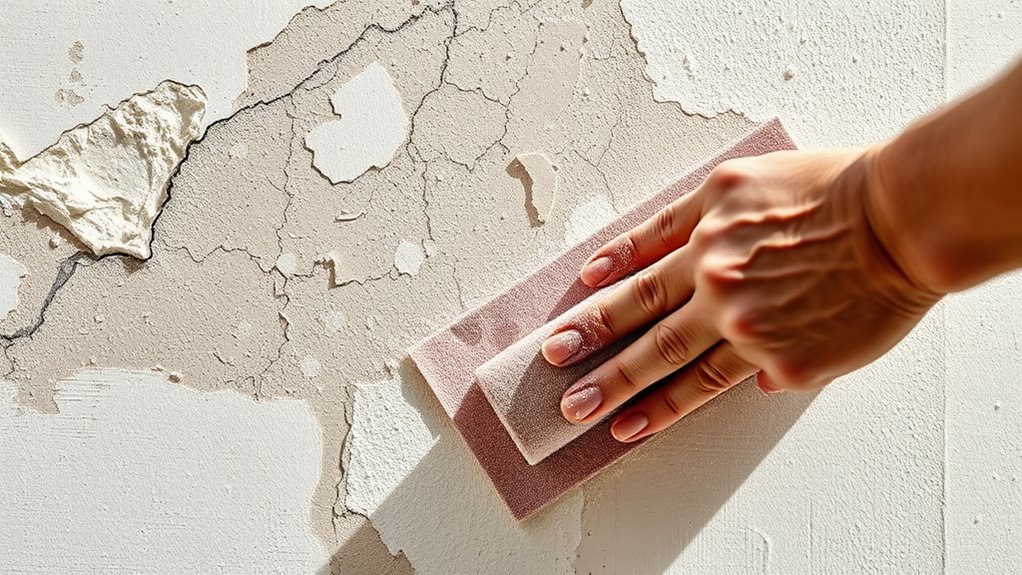
Proper surface preparation and repairs are essential steps that can greatly impact the overall cost of wallpapering. You’ll need to invest in surface smoothing to guarantee an even application and avoid bubbles or wrinkles. Correct adhesive selection is also critical; using the right type prevents future peeling and reduces rework. Preparing your walls might involve filling holes, sanding rough patches, and cleaning surfaces, which adds to labor costs. Additionally, addressing moisture issues beforehand can prevent wallpaper damage later. Incorporating proper machine setup ensures a smoother application process and minimizes potential issues during installation.
- Removing old wallpaper or paint residues
- Filling holes and cracks for a smooth surface
- Sanding rough patches for surface smoothing
- Choosing the appropriate adhesive for your wallpaper type
Measuring and Estimating Material Needs
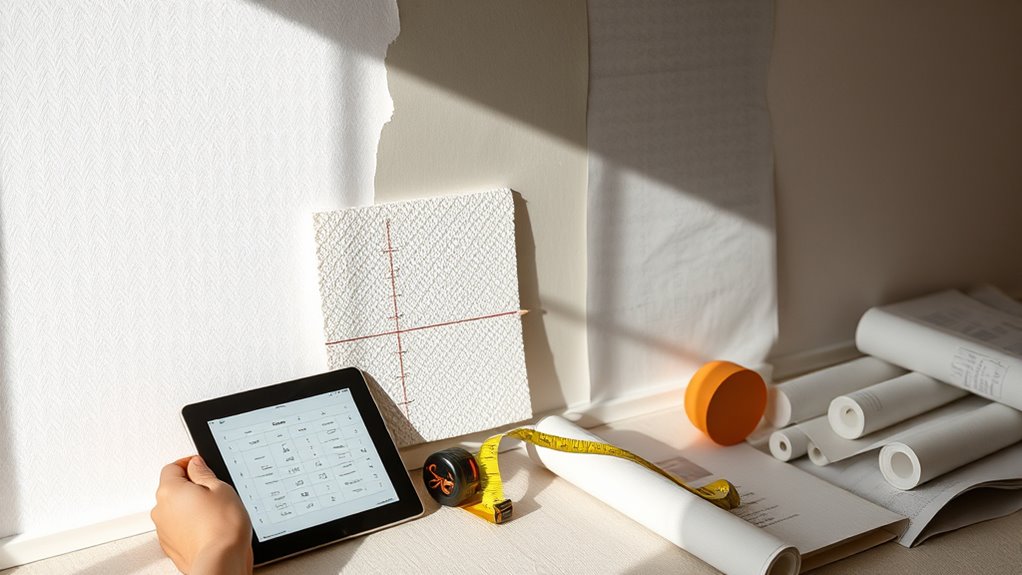
Accurately measuring your walls is essential to estimating how much wallpaper you’ll need and avoiding unnecessary expenses. First, measure the height and width of each wall, then multiply to find the total surface area. Consider pattern matching, which may require extra wallpaper for alignment. To estimate adhesive quantity, check the wallpaper’s coverage per roll and follow manufacturer guidelines—usually around 2-3 inches of adhesive per square foot. Use this table to help organize your measurements and calculations:
| Wall | Area (sq ft) | Pattern Matching Needed | Extra Wallpaper Needed |
|---|---|---|---|
| 1 | 120 | Yes | 10% |
| 2 | 100 | No | 5% |
| 3 | 80 | Yes | 8% |
| 4 | 110 | No | 6% |
| 5 | 90 | Yes | 7% |
This guarantees precise material estimates, reducing waste and cost. Additionally, considering wall surface conditions can ensure proper adhesion and longevity of the wallpaper. Being aware of material quality can also influence the durability and overall appearance of your wallpaper installation. Proper preparation and understanding of installation techniques are crucial for achieving a professional finish. Moreover, thorough measurements help in planning for pattern matching and minimizing errors during installation.
Labor Rates and Professional Installation Fees

Your wallpapering project’s cost will depend on the labor rates and installation service charges in your area. Hourly labor costs can vary widely, affecting the overall price you pay. Additionally, installation service charges may include extra fees for wall preparation or expedited service. Using professional installers familiar with regional legal resources options and procedures can sometimes influence overall costs if they require specific handling or setup procedures.
Hourly Labor Costs
Hourly labor costs for wallpapering vary depending on where you live and the complexity of the job. Factors like installing a decorative border or matching intricate patterns can increase labor time, raising your costs. Professional installers often charge based on hourly rates, which can differ markedly by region. Keep in mind that adhesive costs are usually included, but some professionals may charge extra for specialty adhesives. The complexity of the wall surface, such as uneven walls or existing damage, also affects the time needed. For simple rooms, expect lower hourly rates, while more detailed projects demand higher fees. Understanding these nuances helps you budget accurately and avoid surprises, ensuring your wallpapering project fits your financial plan. Also, being aware of reliable backup power options can help you prepare for unexpected situations during any home renovation. Additionally, considering brand reputation can guide you toward choosing experienced installers who deliver quality work. Incorporating mindfulness techniques during planning can reduce stress and improve decision-making throughout your project. Familiarity with labor cost variations can further help you negotiate fair prices and choose the right professionals for your needs.
Installation Service Charges
Ever wondered how much professional installation services will cost for your wallpaper project? Your total charges depend on factors like the wallpaper pattern and adhesive selection. Professional installers typically charge a flat fee or hourly rate, which varies by location and experience. If your wallpaper has a complex pattern that requires careful matching, expect higher labor costs. Additionally, choosing premium adhesive or specialty glues can increase expenses, but they ensure a smoother, longer-lasting finish. Some installers include pattern alignment and surface preparation in their service charges, while others charge extra. To get an accurate estimate, clarify what’s included—such as handling different wallpaper types or intricate designs. Recognizing professional installation fees can help you compare quotes and select the best value for your project. Understanding these installation service charges helps you budget effectively for a flawless wallpaper application. For example, pattern matching can significantly impact the overall labor time and cost.
Additional Supplies and Equipment Expenses
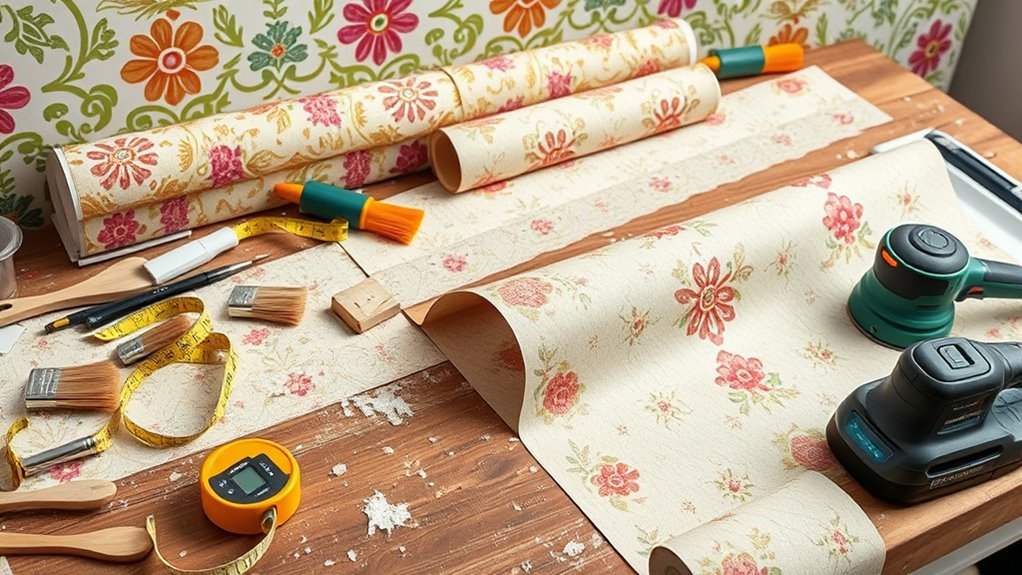
When wallpapering, additional supplies and equipment can substantially impact your overall costs. Beyond the wallpaper and labor, you’ll need tools required for preparation and application, as well as the right adhesive selection to guarantee a smooth finish. These expenses can add up but are essential for quality results. Consider the following:
- Wallpaper steamer or paste remover for prepping surfaces
- Smoothing tools and brushes to eliminate air bubbles
- Drop cloths and masking tape to protect furniture and trim
- Level and measuring tape for precise pattern alignment
- Using the correct adhesive ingredients is crucial for ensuring the longevity and proper adhesion of the wallpaper. Proper retail hours knowledge ensures you can access supplies when needed, preventing delays. Investing in proper tools and adhesives ensures a professional look, but it also increases your total expense. Budget accordingly to avoid surprises and guarantee a successful wallpapering project. Additionally, understanding tuning options for your specific vehicle can help you select the right components and avoid unnecessary costs.
Complexity of the Pattern and Design Choices
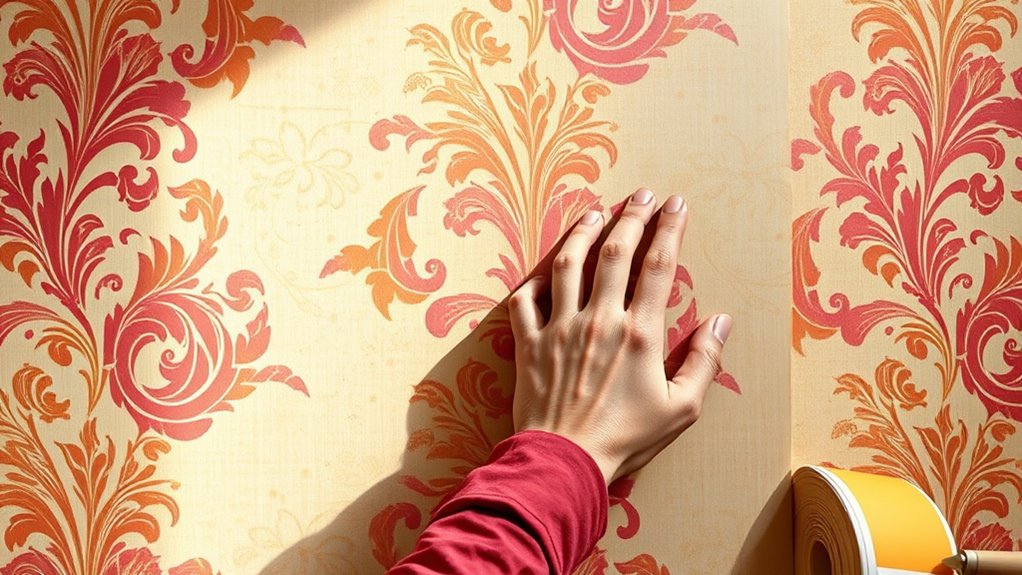
The complexity of your wallpaper pattern and design choices directly influences both the difficulty and cost of your project. Intricate patterns require more precise alignment, careful matching, and additional time, which increases labor costs. If you opt for custom designs, expect higher expenses due to specialized printing processes and tailored preparation. Bold or complex motifs often demand extra attention during installation to ensure seamless results, further raising labor fees. Conversely, simple, repetitive patterns are quicker and easier to apply, reducing overall costs. When choosing your wallpaper, consider how detailed patterns impact your budget. While intricate designs can transform a space beautifully, they also require more skill and time, making them a significant factor in your project’s total expense. Additionally, the design complexity can influence the amount of waste material generated during installation, affecting overall material costs. Careful planning and selecting appropriate patterns can help manage installation difficulty and control costs effectively. Moreover, understanding the integration of design elements can assist in selecting patterns that are both visually appealing and cost-efficient, especially when considering pattern matching.
Geographic Location and Market Variations
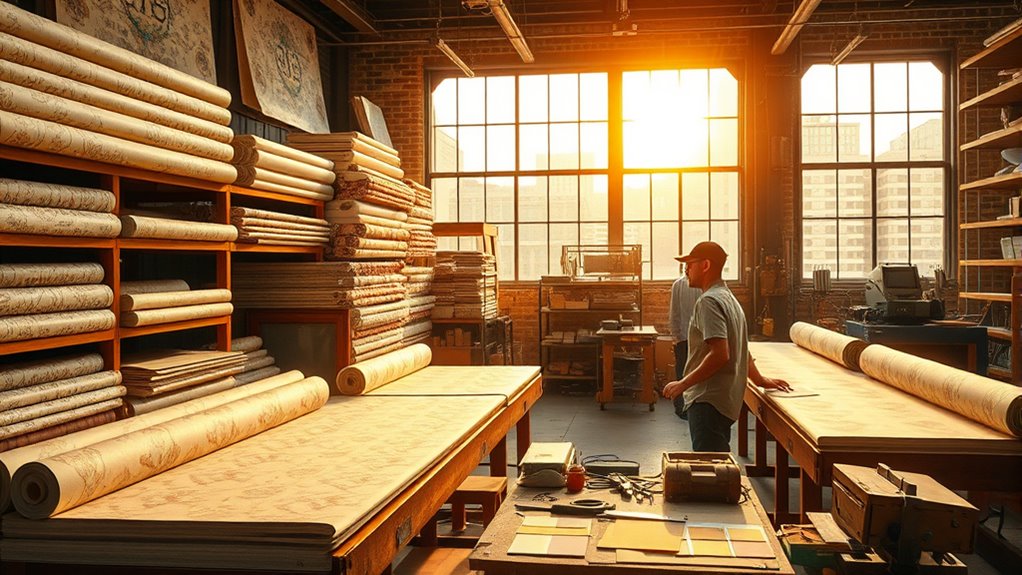
Geographic location and regional market conditions considerably influence wallpaper costs. Regional pricing varies due to factors like local demand, availability of materials, and labor costs. Market fluctuations in different areas can lead to higher or lower prices for both materials and installation. Understanding these differences helps you plan your project budget more accurately. For example, urban areas often have higher labor rates and material costs compared to rural regions. Additionally, certain locations may experience supply chain delays, affecting pricing and availability. Keep in mind that seasonal trends and local economic conditions also impact costs. By considering these geographic factors, you can better anticipate potential price variations and make informed decisions when choosing materials and hiring professionals. Being aware of market fluctuations ensures you avoid surprises and stay within your budget. Waterparks regional availability and seasonal popularity can also influence pricing and accessibility for related services.
Frequently Asked Questions
How Do Seasonal Changes Affect Wallpapering Costs?
Seasonal changes can impact your wallpapering costs through seasonal pricing and weather delays. During busy seasons like spring and summer, prices may be higher due to increased demand. Conversely, off-peak times might offer discounts. Weather delays are common in winter and rainy seasons, causing project postponements and potential extra costs. Planning your project during favorable weather conditions can help you save money and ensure smoother installation.
Are Eco-Friendly Wallpapers More Expensive Than Traditional Options?
Eco-friendly options are often more expensive than traditional wallpapers, but the cost comparison varies based on brands and materials. You might pay a premium for sustainable options like recycled or natural fibers, yet many eco-friendly wallpapers offer durability and health benefits that can save you money in the long run. Weigh these factors carefully when choosing your wallpaper, as investing in eco-friendly options can be worthwhile despite the initial higher cost.
What Impact Do Wall Height and Room Size Have on Costs?
Wall height and room size considerably impact wallpapering costs. Taller walls require more wallpaper and extra labor, increasing expenses. Larger rooms mean more surface area to cover, which also raises material and labor costs. You’ll notice higher prices as wall height and room size grow, because more material is needed and it takes longer to complete the job. Planning for these factors helps you budget accurately for your wallpaper project.
Do Hiring a Specialist Increase Overall Wallpapering Expenses?
Hiring a specialist can increase your overall wallpapering expenses, but it often saves you money long-term. Professionals use professional tools and handle wallpaper removal efficiently, reducing mistakes and rework. Their expertise guarantees a smooth application, minimizing waste and potential damage. While their rates might be higher upfront, their skill can lead to better results, saving you money on repairs or redo costs later.
How Do Custom or Designer Wallpapers Influence Total Costs?
Custom or designer wallpapers markedly increase your total costs because they often feature luxury designs and use rare materials. These unique elements mean higher prices for the wallpaper itself and may require specialized installation, adding to labor costs. If you want a distinctive look, expect to pay more for the exclusivity and quality of these wallpapers, but they can create a stunning, personalized space that truly stands out.
Conclusion
Understanding the costs involved in wallpapering helps you budget wisely. Did you know that professional installation can add up to 60% more to your project costs compared to DIY? By considering factors like materials, surface prep, and complexity, you can make smarter choices. Keep in mind, choosing intricate patterns or living in a high-cost area could substantially impact your budget. Planning ahead ensures your wallpaper project stays on track financially and looks great!


